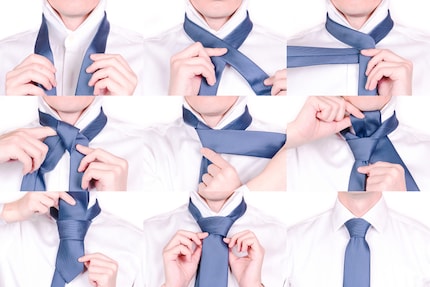
Guide
Dress code etiquette for wedding guests: how to avoid putting your foot in it
by Vanessa Kim

I don't want to step on your toes, but you should follow these five styling rules the next time you tie a tie. Whether you're at a wedding or in the office - this guide will help you tie the right knot.
What handbags and shoes are to women, ties and socks are to men. Sure, you're probably not that keen on wearing one. But with the right model, you can get a lot out of your outfit. You can give a classic suit a modern look in an instant. I'll tell you what to look out for if you need to put one on for your next formal meeting or a more upscale celebration.
The right button is half the battle. If it's sloppy, you've already lost. Even the most expensive tie won't help. It doesn't help that buttons are a dime a dozen. It's best to focus on two variants: the simple one and the Windsor knot. The simple may be simple, but it comes across as casual. If you want to look serious, I recommend the Windsor version. This button is a little more distinctive and wider. Bear in mind here too: The larger and more elaborate the knot, the longer the tie needs to be.

You can also do two things wrong here: The tie is either worn too long or too short. Ideally, it should cover the waistband or belt by about one centimetre. Also important: you must tuck the back of the tie into the loop at the back. Yes, the so-called passantino actually has a function. It ensures that the narrow end does not protrude unattractively from under the front tip of the tie.
Your suit should be darker than your shirt. Ideally, the tie should be in between in terms of colour, creating a harmonious transition from the shirt to the two-piece suit. If you don't have a tie that picks up on both colours, choose one that picks up on the colour of the suit. However, you should avoid colour contrasts that are too strong.
Solid colours: If you're stressed in the morning, it's best to go for a solid-coloured tie that you can mix and match. If the tie is the same colour as your shirt (although this is a no-go according to #3), use a different material to make it stand out from the shirt. In this case, I recommend a fabric made of silk or with a woven structure. With a classic double-breasted suit in calm tones such as black, anthracite, blue or dark brown, you can be bold and go for a tie in a bright colour such as red or purple.

Pattern valid: When it comes to prints, striped ties have become a print classic and are now also popular for formal occasions. As a rule, the wider the spacing and the narrower the stripes, the more formal your appearance. If you want to do everything right, match the colour of your shirt or suit to the stripes. Alternatively, you can also opt for a dotted model. The pattern is simple, but still an eye-catcher.
The standard tie is around seven centimetres wide. If you prefer the narrow version, I advise you to wear a slim-fit double-breasted tie, as otherwise it will look disproportionate. These look particularly good on slim-fit men. If you are rather corpulent, I would advise against it per se. Also a slim-fit suit. Instead, opt for a classic cut model. Speaking of proportions: If you don't want to emphasise your belly unnecessarily, a subtle, plain-coloured model is the better choice.
Even if you want to make a lasting impression on your date: leave your tie at home on your first date - unless you're going to a ball or the opera. You also need to be careful with these dress codes: Black and white tie. This supreme discipline calls for a bow tie. You don't wear this with a conventional suit, but with a dinner jacket or tailcoat.
Follow my bundled buying guides by clicking on the button on my author profile. Click here to go to all ties.
When I’m not exploring the depths of the sea as an open water diver, I enjoy plunging into the world of fashion. On the streets of Paris, Milan and New York is where I keep my eyes peeled for the latest trends. And I’ll show you how to take them from the catwalk to your everyday life.
Practical solutions for everyday problems with technology, household hacks and much more.
Show all